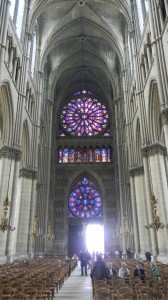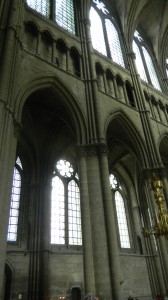So what’s more real, the individual tree, or the general category, tree? People who helped build the great Gothic cathedrals were butting heads over lots of questions.
The world was changing for them, and Gothic cathedrals are masterpieces because they hold keys to medieval views of the universe as society was becoming more complex. People built the earlier Romanesque cathedrals to embody a divine order that everything God created fits into. Folks who built Gothic cathedrals also tried to create a total view of the universe, but how did they when the world was changing so much?
1. One answer comes from the West’s ancient focus on proportion and logic. St. Thomas Aquinas (1221-74) is often considered the greatest medieval philosopher because he synthesized the prior debates into a balanced system. Beauty was a key aspect of his world, and for him, people are attracted to order, clarity and harmony. These reflect the universe which God created–everything has its function and place. Gothic architecture reflects this emphasis on order.
A recent post explained that the use of flying buttresses at the beginning of the 13th century allowed naves to soar more than 100 feet. This greater height allowed the clerestory (the section with the upper level of windows in the above photo) to to be as tall as the bottom colonnade. A system of logical relationships was thus developed.
1. The lower and upper section mirror each other.
2. The middle section, the triforium, reflects the upper part. Thus in the above photo in Rheims Cathedral, each of the 2 windows in the clerestory is mirrored by 2 false windows in the triforium.
3. The ceiling was divided into sections, and each section rises over two columns, and the matching system of triforium and clerestory windows. Each section of the ceiling is handsomely divided into 4 bays.
4. The whole nave is thus a line of segments with logically related components, and this line leads your gaze towards Christ at the altar.
This system was developed at Chartres and Bourges about 50 years before Aquinas was a mature man, so he didn’t spearhead the art form. But his ideas of a universal divine order mirrored it. Both expressed a system that could fit the world’s new diversity into proportioned relationships.
For Aquinas this universal system has room for both the individual tree and the general type. The tree is real, but only as far as it fits the universal pattern for trees. Individual things fit God’s universals in a measured way, as the cathedral’s colonnade and clerestory reflect each other.
This measured and proportionate order is different from the tropical exuberance of Khmer temples and Indian temples, which were built at the same time. Proportion is less prominent in those views of the world–for those societies, the energy that the universe came from is too powerful to be hemmed into one proportionate system.
But within those elegant Gothic lines, artists created an explosion of life that sometimes threatened to leap out. We’ll see vibrancy within these Gothic forms that philosophers might not have envisioned in the next post on Gothic style.





Comments on this entry are closed.